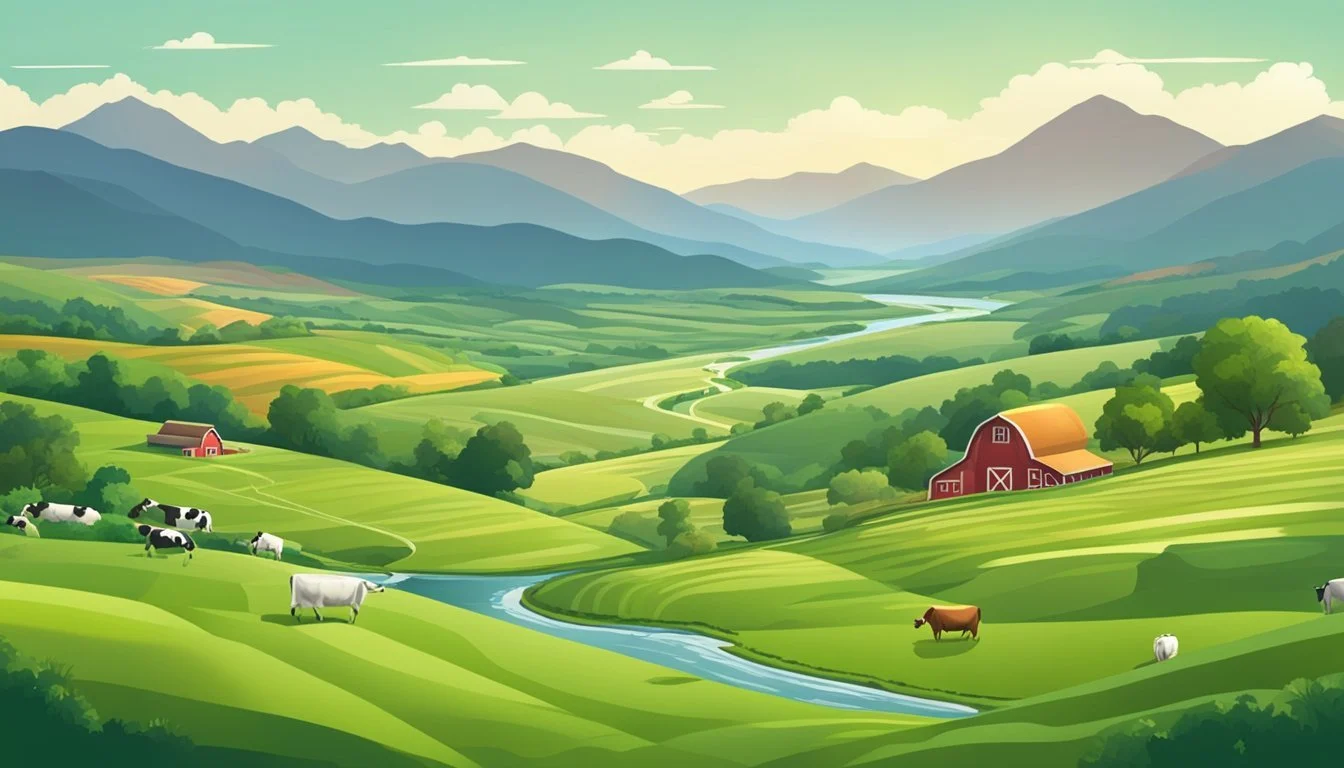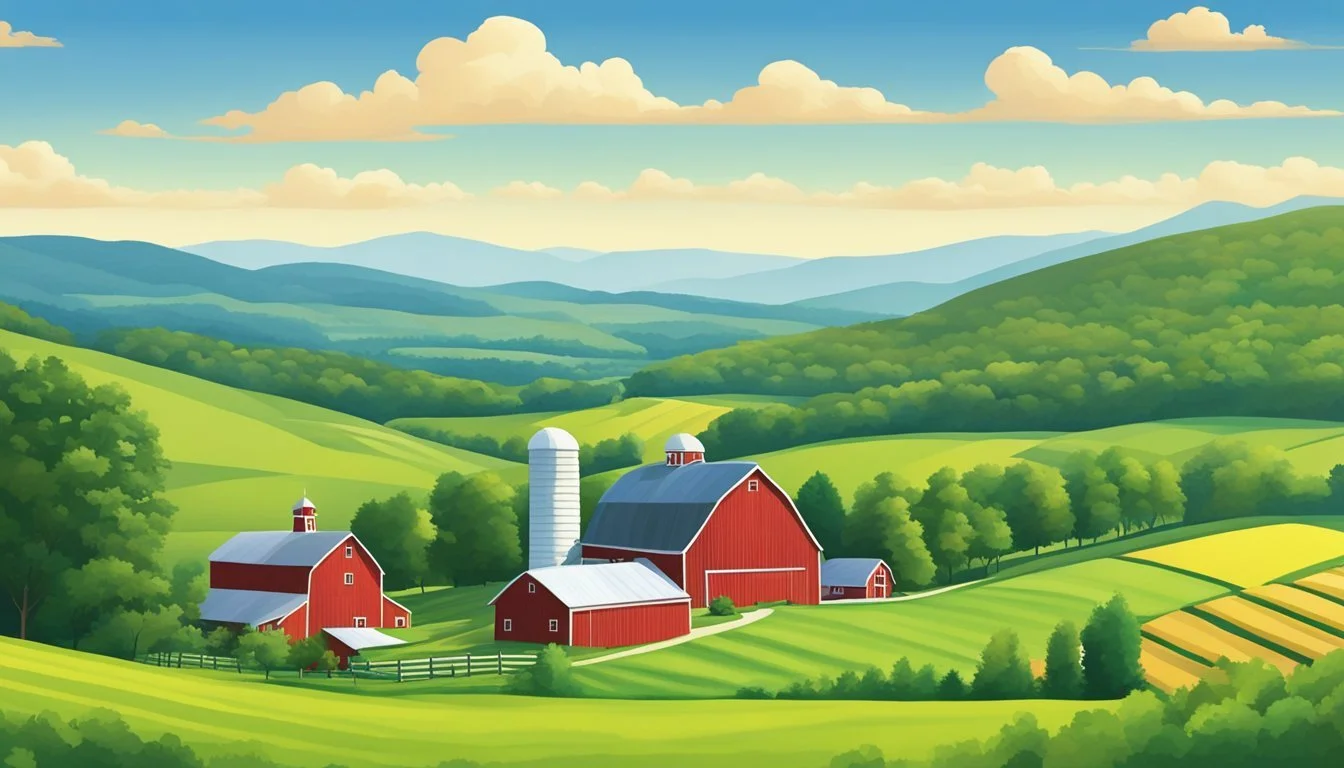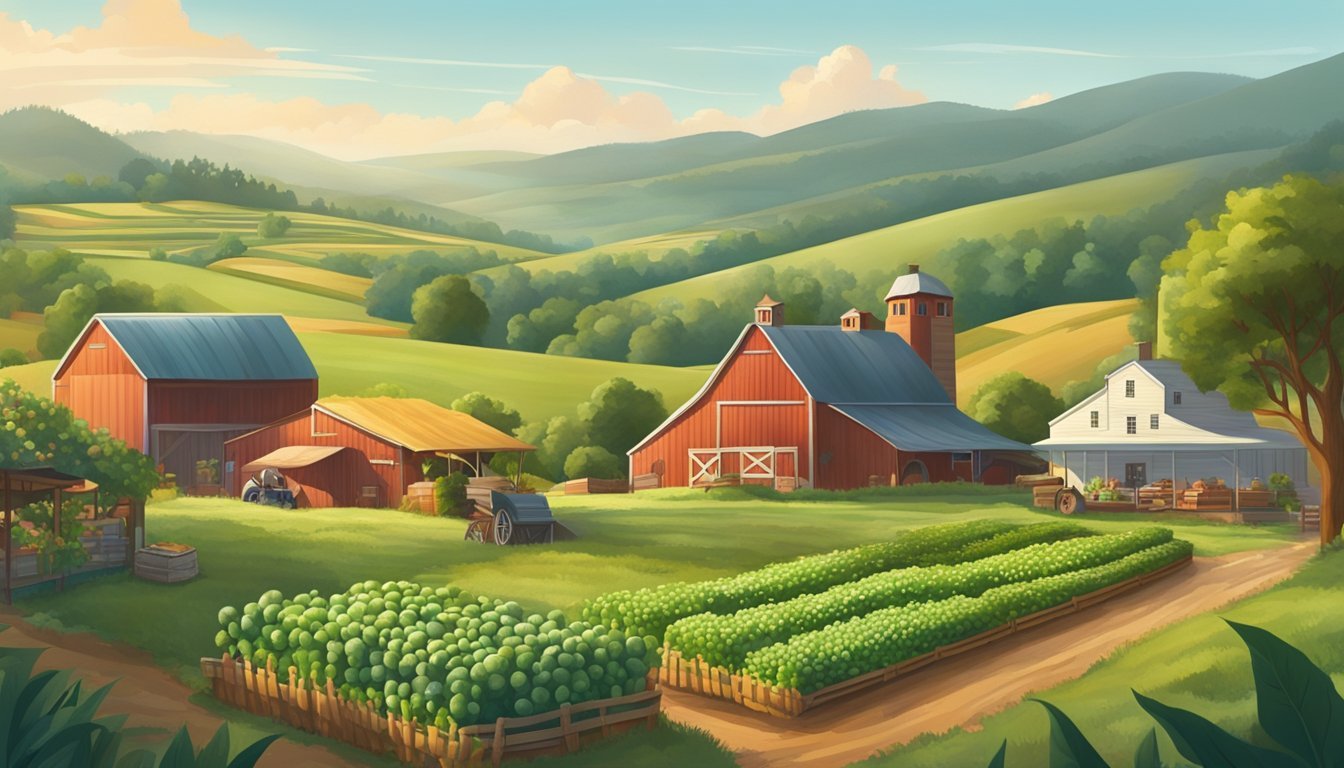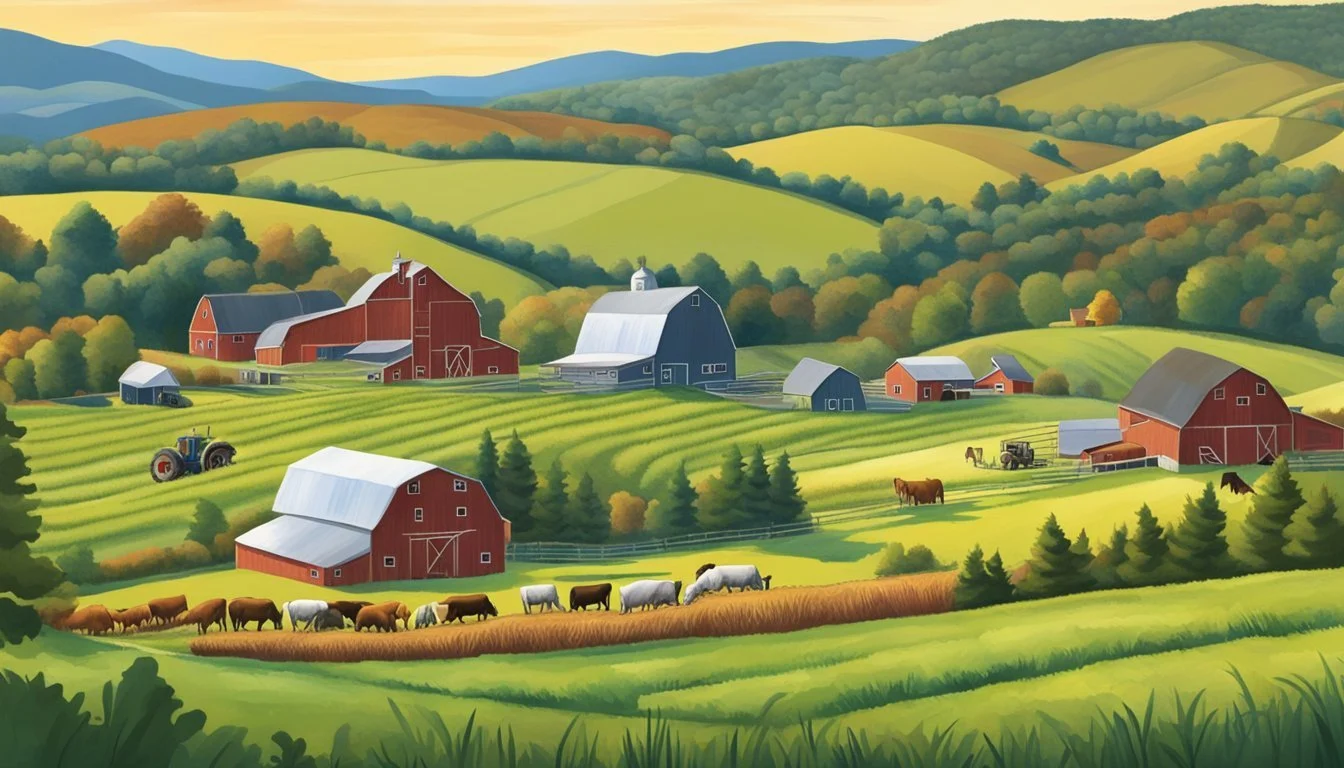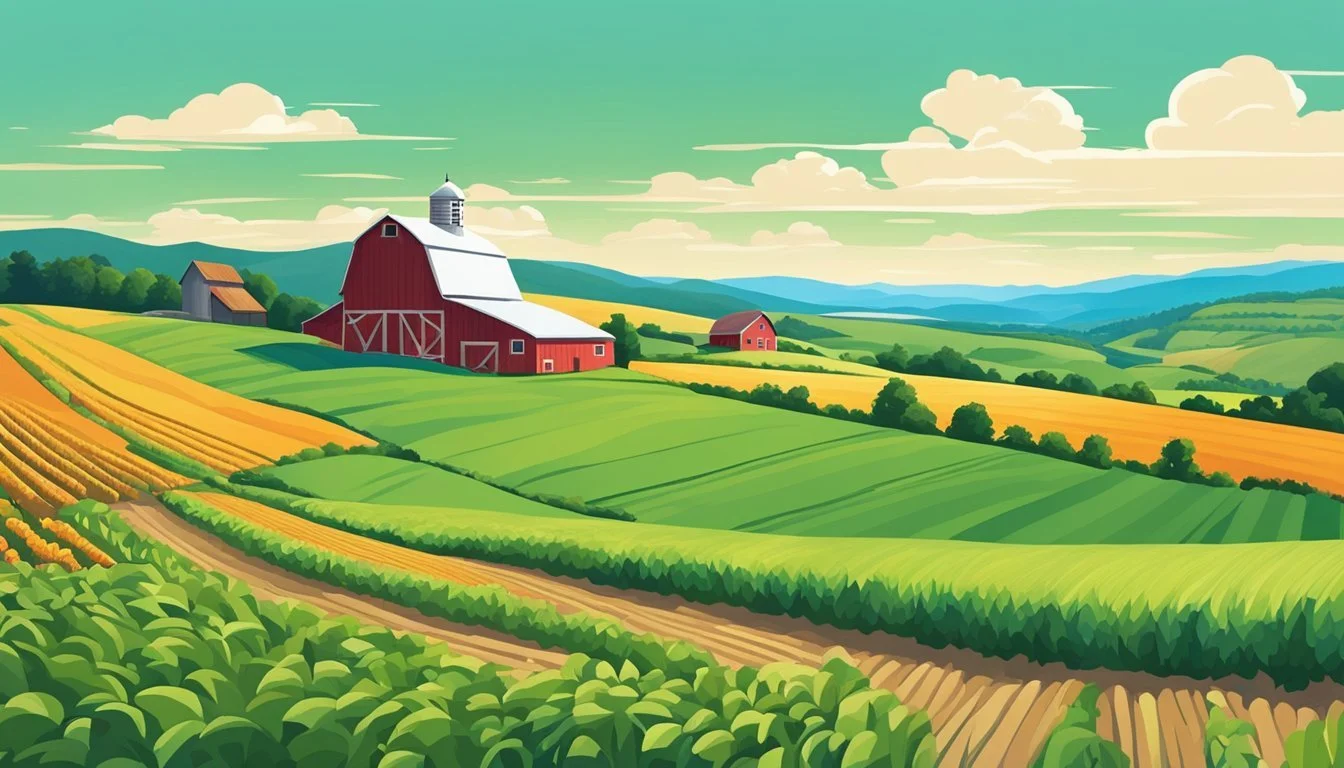Guide to Farming in Vermont
Essential Tips for Success
This Article is Part of Our State by State Farming Guide
Vermont's agricultural sector is marked by its robust support networks and community involvement, crucial elements for both seasoned and new farmers navigating the landscape of rural cultivation. Characterized by its diverse terrain, which includes the hilly and rocky topography of the Green Mountain State, Vermont presents a unique blend of challenges and opportunities for farming. The state is known for a variety of agricultural outputs, primarily dairy, as well as other livestock and crops suited to its climate, like apples and maple syrup.
The community in Vermont is central to its identity, with many of the farms operating as family-run ventures that contribute to the state's rural makeup. Initiatives and resources such as Land For Good and the Northeast Farmers of Color Land Trust play an instrumental role in ensuring that land access, tenure, and transfer are managed with expertise and sensitivity. They cater to the needs of a diverse range of farmers, including Indigenous, Black, Latinx, and Asian communities, helping to advance land sovereignty and secure stable land tenure.
For those aspiring to enter into Vermont's farming industry, an array of resources is available. Collaboration between agricultural organizations fosters a supportive environment for new and aspiring farmers. The Vermont New Farmer Network, for instance, exemplifies this support structure, aiming to fortify the state's future in agriculture by offering guidance to those at the beginning of their farming journey. Through shared knowledge and strategic planning, Vermont's agricultural community stands as a testament to the strength found in collaborative effort and mutual support.
Understanding Vermont's Farming Landscape
Vermont's farming landscape is integral to its identity, characterized by a dedication to land conservation and a robust agricultural framework. This section explores the state's rich agricultural history, the current state of farming, and regional characteristics that define Vermont agriculture.
Historical Context
Farming in Vermont has deep roots dating back to the original settlers, establishing a tradition of dairy and crop farming that persists. Over the years, agriculture has remained a cornerstone of Vermont's economy and culture, with dairy being the predominant sector. Historically, small family farms have dominated the landscape, shaped by the rolling hills and challenging New England climate.
Current Conditions in Vermont Agriculture
Farming In Vermont Today:
Land Use: Farming actively confronts modern pressures with strategies like land use planning and regulatory tools like zoning.
Focus Areas: Farmland preservation remains critical, with efforts to sustain agriculture and assist new and beginning farmers forging a livelihood.
Challenges: Farmers wrestle significant challenges such as market volatility and climate change.
Current farming practices reflect a blend of traditional methods with innovative approaches, pivoting towards sustainability and local food systems.
Regional Specificities
The topographical and climatic nuances of Vermont significantly influence its agricultural capacity, with the state carved into distinct regions:
Northern Vermont: Known for dairy farms leveraging the flatter landscapes.
Central Vermont: Mix of dairy and crop production; land conservation efforts are prominent.
Southern Vermont: Smaller-scale farms, diverse agricultural activities owing to variable terrain.
The regional diversity within Vermont's agricultural sector allows for a broad spectrum of farming practices and crop specializations, underpinned by a strong support network and local food movement which champions farm-to-plate initiatives.
Getting Started in Vermont Farming
In Vermont, aspiring farmers are met with a wealth of resources and support systems designed to facilitate a successful entry into agriculture, including avenues for land acquisition, business planning, and educational programs.
Access to Land and Resources
Access to land is a crucial step in establishing a farm in Vermont. The state provides various land access resources for new and beginning farmers. Programs like the Vermont Land Trust offer opportunities for land ownership, aiming to keep agricultural land affordable. Additionally, organizations such as the Vermont Agency of Agriculture, Food & Markets offer guidance on regulations, permits, and construction on farms to ensure that farmers can utilize their land effectively.
Resources Available:
Vermont Land Trust
Vermont Agency of Agriculture
Business Planning and Management
For new farmers, crafting a strong business plan is a fundamental component of farming in Vermont. A business plan encompasses everything from financial projections to market strategies. Farmers can find business planning and advising through entities like the University of Vermont (UVM) Extension, which provides technical assistance and targeted support for Vermont agriculture. This includes financial aid options like grants and loans tailored to agricultural businesses.
Key Components of a Business Plan:
Financial Projections
Market Strategies
Technical Assistance (e.g., UVM Extension)
Agricultural Education and Support Systems
Education is another pillar of successful farming in Vermont. New farmer courses and support systems like the Farm Beginnings program offered by Northeast Organic Farming Association of Vermont (NOFA Vermont) prepare individuals with the necessary agronomy and farming practices. Ongoing support and continued learning are available from organizations like Rural Vermont, which provides resources and advocacy for farmers, with a focus on sustainable farming practices including dairy and crop production.
Educational Opportunities:
NOFA Vermont's Farm Beginnings
Rural Vermont Support
These initiatives ensure that Vermont remains a robust environment for new and established farmers alike, promoting a thriving agricultural community through sustainable practices and continuous learning.
Farm Operations Management
In Vermont, efficient farm operations management is crucial for the viability of the agricultural sector. It encompasses a wide array of responsibilities from crop production and livestock care to sustainable environmental practices and maintaining farm infrastructure.
Crop Production and Livestock Care
Crop production in Vermont relies heavily on understanding local climate conditions and soil health, as these factors directly affect yield and quality. Farmers must choose suitable crops and implement effective management strategies to optimize production. Livestock care is another pivotal aspect, which includes ensuring adequate nutrition—often involving hay and feed management—and health monitoring to maintain animal welfare and productivity.
Soil Health: Regular soil testing and nutrient management to enhance crop production.
Feed Management: Strategic feed and hay allocation to sustain livestock health.
Sustainable Practices and Environmental Impact
Sustainable farming practices are highly regarded in Vermont, not only for their positive environmental impact but also for long-term farm viability. Operations are encouraged to manage on-farm nutrients and minimize waste, aligning with Required Agricultural Practices (RAP) to maintain soil and water quality.
Nutrient Management: Account for all nutrient sources and adjust application rates based on waste analysis.
Environmental Conservation: Implement practices that reduce environmental impact and enhance sustainability.
Farm Infrastructure and Equipment
Robust farm infrastructure and reliable equipment are cornerstones of successful farm operations. This includes structures for housing livestock, storage facilities for produce and feed, and machinery vital for both crop production and land management.
Facilities and Structures: Appropriate and efficient farm structures under RAP rules.
Machinery and Technology: Investment in equipment that increases operational efficiency and safety.
Farmers in Vermont are supported by various statewide service providers, which assist in growing management capacities and making sustainable business decisions that reflect the state's commitment to a resilient agricultural future.
Economic Viability and Market Strategies
Economic viability in Vermont's agricultural sector hinges on strategic market engagement and sound financial management. A robust approach to marketing, comprehensive business planning, and an emphasis on diversification are the pillars that support a farm's success.
Marketing and Sales
Farmers in Vermont can capitalize on direct market opportunities, which enable them to capture a greater share of the consumer dollar. They sell their products through a mix of market outlets including farmers markets, Community Supported Agriculture (CSA), and online platforms. Entrepreneurs in the agricultural space should focus on developing a strong farm brand and a marketing plan that engages Vermonters and exposes their products to a broader market.
Strategies for effective marketing:
Establish a distinct brand identity
Utilize social media for promotions
Foster community relationships
Financial Planning and Viability
Sound financial planning is a cornerstone of farm viability. Vermont farmers need to navigate the complexities of agricultural finances, from initial investments to managing operational costs. They must incorporate business assistance programs like the Vermont Farm and Forest Viability Program, which offers funding support including stipends, aiding in the sustainable growth of their operations.
Key elements of financial planning:
Accurate record-keeping
Regular financial analysis and review
Utilization of state-sponsored financial assistance
Diversification and Scaling
Diversification is a strategy that helps mitigate risks and enhances the financial resilience of farms. This can mean growing a variety of crops, incorporating livestock, or adding value-added products to their offerings. When Vermont agricultural businesses diversify effectively, they are better equipped to scale sensibly, expanding their operations to meet increasing market demand without compromising their core values or financial stability.
Approaches to diversification:
Introducing new crop varieties
Adding agritourism activities
Creating artisanal food products
Challenges and Opportunities for Vermont Farmers
Vermont farmers navigate a landscape marked by both, significant challenges—like climate change and limited local markets—and opportunities that come with evolving markets and policy support.
Overcoming Barriers to Success
Farmers in Vermont grapple with increasing land values and limited local market access, making it crucial for them to identify new and sustainable ways to maintain economic viability. The state's climate change impacts further add to the production uncertainties. However, policies that offer support and community-driven initiatives are paving the way for overcoming these barriers.
Innovation and Adaptation to Market Trends
The marketplace's shift demands Vermont farmers to innovate and adapt. Evolving agricultural business models may include sustainable farming practices or expanding into niche markets. Support from agricultural organizations is essential for farmers to stay abreast of such market trends and adapt their operations accordingly.
Advocacy, Policies, and Community Support
Strong advocacy and beneficial policies can create a supportive environment for farmers. Nurturing a collaborative community among farmers and food systems stakeholders is vital to bolster Vermont's rural economic development. Policymakers are called to heed the barriers farmers face and sculpt policies conducive to sustaining the agricultural sector amidst modern-day challenges.
Regulations, Safety, and Quality Assurance
In Vermont, agriculture is guided by a framework that emphasizes food safety, pest management, and adherence to regulations. This ensures the integrity of the food system, helping farms maintain high standards of produce safety and regulatory compliance.
Food Safety and Regulations
Vermont's Agency of Agriculture, Food and Markets provides comprehensive produce safety resources. While the Produce Safety Rule is a federal mandate, Vermont encourages all farms, regardless of size, to utilize local resources for growing produce safely. This includes worker training programs which are crucial for maintaining a safe production environment. Regulations also cover the Required Agricultural Practices (RAPs), which determine the application of land use regulations and outline farm operation practices. This is especially pertinent for farms that meet the specific thresholds defined by these regulations.
Produce Safety Rule Subpart C: Focuses on Worker Training.
RAPs: Apply to farms of varying sizes with additional requirements for larger operations.
Disease and Pest Management
Preventing the spread of disease and managing pests is vital to maintaining a healthy food system. Vermont provides standards and resources aimed at reducing cropland erosion, sediment, and nutrient losses, which can affect both crop health and environmental safety. Farmers are expected to implement farm management techniques that mitigate these risks, and in doing so, they contribute to a more robust and disease-resistant food system.
Certifications and Compliance
Compliance with federal and state regulations is backed by various certifications that Vermont farms can acquire. Adherence to these standards is not only about following rules but also about participating in USDA programs like 3SquaresVT which can help farms reach compliance while supporting the local food system plan. Certificates and compliance ensure that farms follow best practices in sustainability, safety, and productivity.
3SquaresVT: A program connected with USDA to support food access.
Food System Plan: A blueprint for creating a sustainable and safe food landscape in the state.
Local and Global Networks
Vermont’s agricultural sector benefits from an extensive network of local and global connections, enhancing the state's food systems through non-profit partnerships, international market access, and responsive consumer demands.
Partnerships with Non-Profits and Co-Ops
Non-profit organizations greatly support Vermont farmers by providing vital resources and educational opportunities. The Vermont New Farmer Network, for example, comprises various member organizations dedicated to assisting new and aspiring farmers. The Center for an Agricultural Economy is instrumental in fostering community engagement and advancing sustainable agricultural practices among local food entrepreneurs.
Services offered include:
Agricultural education
Business planning
Market development
Cooperative models offer farmers collective bargaining power and shared resources for better market presence. They often play a significant role in integrating global food traditions into local markets, empowering diverse agricultural practices.
Connecting with International Markets
Access to international markets is key for Vermont farmers aiming to expand their reach beyond local consumers. Organizations help connect Vermont's produce with markets in New York and beyond, ensuring that Vermont's agricultural products can compete in a global marketplace.
Export strategies involve:
Identifying market demands
Aligning crop selection with international preferences
The Vermont Agency of Agriculture, Food & Markets provides guidance for navigating the complexities of international trade, enabling local farmers to become competitive global players.
Consumer Trends and Demand
The dynamics between local production and global consumption patterns affect Vermont farmers significantly. The increasing consumer interest in locally-sourced and ethically-produced food drives demand for Vermont goods both domestically and internationally.
Key factors influencing consumer demand:
Origin of produce
Sustainable farming practices
Quality and nutritional value of products
Farmers adapt their practices to meet these demands, often incorporating exotic crops that cater to a diverse population and reflect global food preferences. This adaptation ensures the relevance of Vermont's agricultural outputs in a rapidly changing food economy.
Specialized Farming Practices in Vermont
Vermont boasts a diverse agricultural landscape, distinguished by its specialized farming practices that cater to quality dairy production, unique specialty crops, and experiential agritourism.
Dairy and Cheese Production
In Vermont, dairy farming signifies more than just an agricultural activity; it's part of the state's heritage. The state's farmers manage herds of cows to produce high-quality dairy and dairy products. Vermont cheese has earned a reputation for excellence, with an emphasis on artisanal cheese crafted from the milk of local dairy farms.
Cows: Holstein and Jersey breeds predominate in Vermont, known for their rich milk.
Dairy Products: Including cheese, milk, yogurt, and ice cream.
Specialty Crops and Local Delicacies
Farmers in Vermont cultivate a range of specialty crops that contribute to the state's reputation for unique local delicacies. This includes the production of apples, renowned for their crispness and variety, honey from local apiaries, and the seasonal harvesting of Christmas trees. Furthermore, the state is celebrated for its maple syrup, derived from the sap of sugar maples, an iconic Vermont staple.
Apples: Over 150 varieties grown, with a focus on sustainable methods.
Maple Syrup: Supplies nearly 50% of the U.S. production, with a strict quality grading system.
Agritourism and Educational Farms
Agritourism is a vital part of Vermont's agricultural economy, with many farms opening their doors to the public for educational experiences. Through farm stays, tours, and workshops, visitors can connect with the farming lifestyle and learn about the production of local foods right from the source. Agricultural businesses often collaborate to create an immersive experience in Vermont's rural charm.
Corn Mazes and Pumpkin Picking: Seasonal activities that attract tourists.
Educational Workshops: Demonstrating sustainable farming techniques.
In each of these areas, ranchers and agricultural businesses play a crucial role, not only in maintaining the state's agricultural traditions but also in innovating for economic sustainability and environmental stewardship.
Resources and Further Reading
For those delving into the field of agriculture in Vermont, an array of resources and opportunities await. These resources are designed to educate, fund, and legally empower burgeoning and established Vermont farmers.
Educational Material and Workshops
Vermont is home to various organizations that provide educational materials and workshops to farmers. The University of Vermont (UVM) serves as a rich center for agricultural research and offers a Beginning Farmer Resource Hub which is crucial for new growers. The Intervale Center, another keystone in Vermont's agricultural community, provides valuable opportunities for learning and community engagements, such as newsletters and events aimed to strengthen family farms.
Grants and Funding Opportunities
Grants and funding are vital to support and sustain agricultural ventures. The Vermont Agency of Agriculture Food & Markets provides a comprehensive 2022 Guide to Assistance that is accessible to farmers looking for financial support. Organizations such as Rural Vermont and Vital Communities also offer directories and resources that can be navigated to find various funding opportunities suitable for Vermonters' diverse agricultural projects.
Farmers Market Legal Toolkit
Farmers markets are crucial for the distribution of locally-grown produce. Legal knowledge is equally important to ensure they operate smoothly. The Center for an Agricultural Economy and FarmFirst offer resources about laws and best practices for Vermont’s growers and producers. The Farmers Market Legal Toolkit, an invaluable resource, provides legal resources tailored to the specific needs of Vermont farmers markets for the years 2021-2030, ensuring that markets run within legal frameworks and contribute significantly to local economies.
Closing Remarks
Vermont's farming legacy continues to evolve, shaped by an interplay of tradition and innovation. This section affords a glimpse into the prospective horizon of Vermont agriculture, and offers resources for staying engaged with its progression.
Future Outlook for Vermont Farming
The future of Vermont farming beckons with a blend of challenges and opportunities. Rural communities and the next generation of farmers stand at the forefront of shaping this future. Ageing farmers present a significant demographic shift, emphasizing the importance of farmland access for new and young cultivators. The Intervale Center, among other organizations, remains pivotal in nurturing this transition, guiding the handover of arable lands to ensure the continuity of Vermont's agricultural heritage.
Crafting a resilient agricultural framework involves supporting the integration of sustainable practices and diversifying beyond conventional dairy. The state's agricultural landscape is expected to be a patchwork of traditional dairy farms, pioneering organic operations, and novel, niche market ventures.
How to Stay Informed and Involved
Remaining informed and involved in Vermont's agricultural sector is key for both established and aspiring farmers. Farmers are encouraged to capitalize on resources such as the Vermont Agency of Agriculture, Food & Markets and local networks like the Vermont New Farmer Network.
Resources: Access state-coordinated guides and expert insights on land assessment, environmental risk, and market-building strategies.
Networking: Engage with community foundations and agriculture-focused organizations to stay abreast of events, workshops, and webinars.
Advocacy: Participate in policy development and support initiatives that benefit farming communities and the land they steward.
By navigating resource platforms and contributing to the collective voice, one can actively participate in shaping the future of farming in Vermont.


